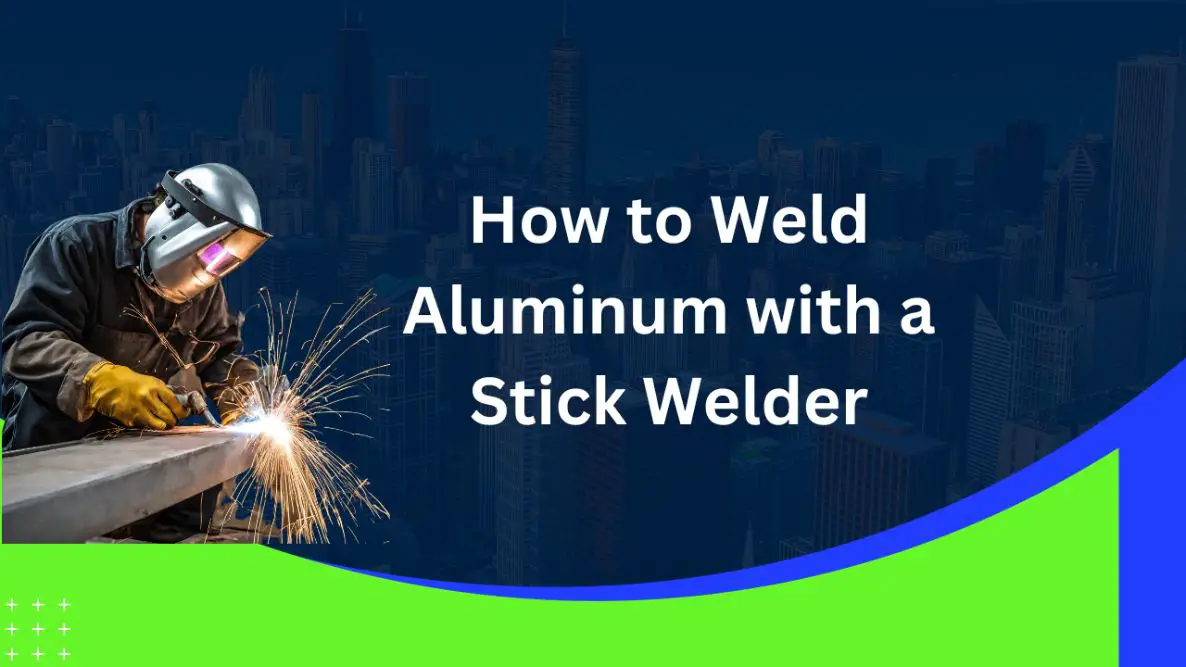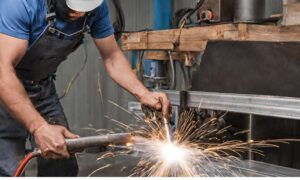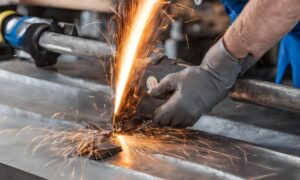Table of Contents
- 1. How to Stick Weld Aluminum
- 2. Preparation for Aluminum Welding
- 3. Setting Up Your Stick Welder for Aluminum
- 4. Welding Techniques for Aluminum
- 5. Troubleshooting Common Issues
- 6. Common Problems in Stick Welding Aluminum
- 7. Comparing Stick Welding with Other Techniques
- Conclusion
- FAQs about How to Weld Aluminum with a Stick Welder
Welding aluminum with a stick welder demands precision amidst unique complexities. Understanding its challenges and mastering the techniques can unlock the potential for strong, durable welds.
In this comprehensive guide, we explore the intricacies of stick welding aluminum, comparing it with MIG and TIG methods, empowering you to conquer the art of welding aluminum with finesse. Join us as we unravel the secrets to successful aluminum welding with a stick welder.
1. How to Stick Weld Aluminum
Welding aluminum with a stick welder presents a unique set of challenges and opportunities. While stick welding (Shielded Metal Arc Welding or SMAW) is a versatile and commonly used technique, welding aluminum with this method demands precision, attention to detail, and a deep understanding of aluminum’s properties.
Understanding the Challenges and Benefits
Aluminum, known for its lightweight and corrosion-resistant properties, is widely used in various industries, from automotive to aerospace. However, welding aluminum with a stick welder is considered challenging due to several reasons:
- Thermal Conductivity: Aluminum’s high thermal conductivity causes it to dissipate heat rapidly, making it susceptible to warping, distortion, and burn-throughs during welding.
- Oxide Layer: Aluminum naturally forms an oxide layer that melts at a much higher temperature than the base metal. This layer needs to be meticulously cleaned before welding to ensure a strong bond.
- Electrode Selection: Choosing the right electrode for aluminum welding is crucial. Standard electrodes used in steel welding are not suitable for aluminum due to differences in melting temperatures and material properties.
However, despite these challenges, stick welding aluminum offers certain advantages:
- Portability and Accessibility: Stick welders are portable and can be used in various locations, making them suitable for on-site repairs or projects.
- Versatility: With the right techniques and equipment, stick welding aluminum can produce strong and durable welds.
- Cost-Effectiveness: Stick welding machines are often more affordable compared to other specialized aluminum welding equipment.
Mastering the art of stick welding aluminum involves a blend of technical know-how, precise equipment setup, and hands-on experience. Throughout this guide, we’ll delve into the intricacies of preparing, setting up, and executing successful aluminum welds using a stick welder. By understanding the challenges and benefits, you’ll be better equipped to navigate the nuances of welding aluminum with this technique.
2. Preparation for Aluminum Welding
Welding aluminum successfully hinges on meticulous preparation. Unlike welding other metals, aluminum demands specific attention to cleanliness and material handling to achieve strong and durable welds.
Surface Cleaning and Preparing Aluminum
- Cleanliness is Paramount: Aluminum readily forms an oxide layer that must be removed before welding. Use a stainless steel brush or chemical cleaner specifically designed for aluminum to eliminate this oxide layer and any contaminants on the surface. This step ensures a clean welding surface, promotes better adhesion, and reduces the risk of defects in the weld.
- Material Handling: Aluminum is highly sensitive to contamination. Proper handling, including wearing gloves to prevent oil transfer from the skin, using clean tools, and storing aluminum in a clean environment, is crucial to maintaining its welding integrity.
Selecting the Right Equipment and Electrodes
- Electrode Choice: Standard electrodes won’t suffice for aluminum welding. Opt for specialized aluminum electrodes like E4043 or E5356, chosen based on the aluminum’s thickness and the welding position (flat, horizontal, vertical, or overhead).
- Welding Machine Setup: Ensure your stick welding machine is compatible with aluminum welding. Check for necessary adjustments and ensure the correct polarity (AC for aluminum welding) and grounding to facilitate successful welds.
By investing time in meticulous surface preparation and selecting appropriate equipment and electrodes, you lay a strong foundation for successful aluminum welding. These preparatory steps mitigate potential issues and set the stage for clean, durable welds.
3. Setting Up Your Stick Welder for Aluminum
Configuring your stick welding machine appropriately for aluminum welding is a crucial step that directly influences the quality and integrity of your welds.
Adjusting Settings and Safety Measures
- Amperage Settings: Refer to the electrode manufacturer’s recommendations for the appropriate amperage settings. Aluminum welding typically requires a higher amperage compared to steel welding. Adjust the machine’s amperage settings accordingly to ensure optimal heat output for effective aluminum welding.
- Polarity and Grounding: Unlike steel welding, aluminum welding requires an AC (alternating current) polarity. Ensure your stick welder is set to AC mode for aluminum welding. Additionally, proper grounding is vital to maintain a stable electrical circuit and prevent potential issues during welding.
- Safety Considerations: Prioritize safety by wearing appropriate personal protective equipment (PPE), including welding gloves, a welding helmet with a proper shade for aluminum welding, and protective clothing to shield against UV radiation and sparks. Additionally, ensure proper ventilation in your workspace to mitigate exposure to fumes and gases generated during welding.
Ensuring Proper Setup
- Electrode Handling: Store aluminum electrodes in a dry, temperature-controlled environment to prevent moisture absorption, which can lead to weld contamination and defects.
- Welding Machine Calibration: Check the accuracy of your welding machine’s settings and calibration before starting the welding process. This step ensures consistent and reliable performance during aluminum welding.
By meticulously adjusting settings, ensuring the correct polarity, and prioritizing safety measures, you establish an environment conducive to successful aluminum welding using a stick welder. These preliminary steps pave the way for executing the welding techniques crucial for achieving high-quality aluminum welds.
4. Welding Techniques for Aluminum
Welding aluminum with a stick welder demands specialized techniques to overcome its unique challenges and ensure the creation of strong, durable welds.
Proper Positions, Angles, and Heat Management
- Arc Length Control: Maintain a short arc length while welding aluminum. This control prevents excessive heat buildup, minimizes distortion, and aids in better puddle control, crucial for achieving clean and uniform welds.
- Electrode Manipulation: Employ a weaving or slight circular motion while welding. This technique helps distribute heat evenly, ensuring proper fusion between the aluminum pieces and minimizing the risk of defects like cracks or porosity.
- Heat Management: Aluminum’s high thermal conductivity necessitates careful heat management. Avoid prolonged exposure to high temperatures, as excessive heat can lead to burn-throughs or distortion. Control heat input by adjusting travel speed and manipulation techniques to maintain a consistent and controlled welding environment.
Preventing Warping and Ensuring Penetration
- Proper Welding Positions: Consider the welding position (flat, horizontal, vertical, or overhead) when welding aluminum. Adjust your technique to accommodate the position, ensuring proper heat distribution and penetration throughout the weld joint.
- Preventing Warping: Use intermittent welding to allow the aluminum to cool between passes, reducing the likelihood of warping. Implementing proper cooling techniques, such as backstepping or staggering welds, helps manage heat distribution and prevents distortion.
- Ensuring Penetration: Monitor the weld bead closely to ensure adequate penetration without causing excessive melting or burning through the material. Adjust settings and techniques to achieve a strong fusion between the base metal and filler material.
By mastering these welding techniques tailored for aluminum, welders can navigate the challenges posed by aluminum’s properties and achieve high-quality welds with a stick welder. These nuanced approaches prioritize precision, control, and adaptability, allowing for successful welding on aluminum surfaces.
5. Troubleshooting Common Issues
Welding aluminum with a stick welder can present challenges, but understanding common issues and having effective troubleshooting techniques can significantly enhance the quality of your welds.
Addressing Common Problems
- Porosity and Inadequate Penetration: If you notice porosity or inadequate penetration in your welds, reassess your settings and welding technique. Adjust the amperage settings or electrode manipulation to ensure proper heat input and penetration. Additionally, verify that the aluminum surface is adequately cleaned and free from contaminants.
- Cracking: Cracks in aluminum welds can result from excessive heat or inadequate fusion. Reduce heat input, consider preheating the aluminum, and adjust welding techniques to control heat distribution, preventing cracks from forming.
- Rough Appearance: Uneven or rough weld appearances may stem from inconsistent heat or improper electrode manipulation. Focus on maintaining a steady and controlled arc while weaving the electrode smoothly to achieve uniform and aesthetically pleasing welds.
Tips for Improving Weld Quality
- Practice and Patience: Mastering aluminum welding with a stick welder takes practice. Dedicate time to refine your technique and experiment with different settings and electrode manipulation to find what works best for your specific welding scenario.
- Optimize Cleaning: Ensure thorough cleaning of the aluminum surface before welding. A clean surface devoid of oxides or contaminants significantly improves weld quality and integrity.
- Continuous Monitoring: Regularly inspect the weld bead while welding. Adjust settings or techniques promptly if you notice any irregularities to maintain consistency and quality throughout the welding process.
By addressing common issues and implementing these tips, welders can elevate their aluminum welding skills with a stick welder. Patience, attention to detail, and continuous improvement play pivotal roles in achieving high-quality aluminum welds.
6. Common Problems in Stick Welding Aluminum
Stick welding aluminum, although feasible, poses several challenges that welders often encounter. Understanding these difficulties and the potential solutions is crucial for successful aluminum welding.
Why Aluminum Poses Challenges for Stick Welding
- Thermal Conductivity: Aluminum’s high thermal conductivity causes rapid heat dissipation, making it susceptible to warping, burn-throughs, and inadequate fusion during welding.
- Oxide Layer Formation: Aluminum naturally forms an oxide layer that melts at a higher temperature than the base metal. This oxide layer must be meticulously removed before welding to achieve a strong and clean weld joint.
Addressing Specific Issues
- Need for a Short Arc: Stick welding aluminum demands a shorter arc length compared to welding other materials. Maintaining a short arc minimizes heat input, reducing the risk of distortion and ensuring better control over the weld puddle.
- Rough Appearance: Inconsistent heat or improper electrode manipulation can result in a rough or uneven appearance in aluminum welds. Employing a controlled weaving motion and maintaining a steady arc helps achieve smoother and more uniform welds.
- Warping and burn-throughs: Controlling heat input and managing welding positions can mitigate warping and burn-throughs in aluminum welding. Employ intermittent welding techniques and consider preheating or backstepping to manage heat distribution.
Specialized Electrodes and Surface Preparation
- Specialized Electrodes: Using electrodes specifically designed for aluminum, such as E4043 or E5356, is imperative. These electrodes are formulated to match aluminum’s properties and facilitate effective welding.
- Surface Preparation: Thoroughly cleaning the aluminum surface to remove oxides and contaminants is crucial. Chemical cleaners or stainless steel brushes help eliminate the oxide layer, ensuring proper fusion and high-quality welds.
7. Comparing Stick Welding with Other Techniques
MIG Welding for Aluminum
- Process Overview: MIG (Metal Inert Gas) welding, also known as Gas Metal Arc Welding (GMAW), utilizes a continuous wire electrode and a shielding gas to protect the weld area from atmospheric contamination.
- Suitability for Aluminum: MIG welding is highly suitable for aluminum due to its ability to provide a consistent and high-quality weld. The process offers better control over heat input and is less prone to issues like porosity or contamination compared to stick welding.
- Advantages: MIG welding enables faster travel speeds, cleaner welds, and minimal spatter. It’s suitable for thicker aluminum sections and allows for a more straightforward learning curve.
- Considerations: Proper shielding gas (typically pure argon or a mixture) and wire selection are crucial for successful MIG welding on aluminum. Additionally, equipment costs and the need for a clean welding environment are factors to consider.
TIG Welding for Aluminum
- Process Overview: TIG (Tungsten Inert Gas) welding, also known as Gas Tungsten Arc Welding (GTAW), involves a non-consumable tungsten electrode, a shielding gas, and manual filler material feeding, offering precise control over the welding process.
- Suitability for Aluminum: TIG welding is exceptionally well-suited for aluminum due to its ability to produce high-quality, precise welds. It allows for fine control over heat input and weld puddle manipulation, making it ideal for thinner aluminum sections and intricate welds.
- Advantages: TIG welding offers superior control, producing clean, aesthetically pleasing welds with minimal distortion. It’s well-suited for thin materials and intricate joints.
- Considerations: TIG welding demands more skill and practice to master than other methods. It requires a high level of manual dexterity and precise technique. Additionally, it’s slower compared to MIG or stick welding.
Choosing the Right Method for Specific Scenarios
- Stick Welding (SMAW): Stick welding for aluminum, while feasible, presents challenges due to aluminum’s properties. It’s suitable for repairs, fieldwork, or situations where portability is essential. However, achieving high-quality welds demands meticulous preparation and technique.
- MIG Welding: Ideal for thicker aluminum sections, structural work, and fabrication where speed and clean welds are paramount. It offers good penetration and efficiency and is suitable for various aluminum applications.
- TIG Welding: Best suited for thin aluminum sections, critical joints, and applications requiring precise control and aesthetic welds. It’s commonly used in aerospace, artistry, and specialized fabrication where weld quality is a priority.
The choice between stick, MIG, or TIG welding for aluminum hinges on factors such as material thickness, project complexity, desired weld quality, available skill level, and equipment availability. Each method has its strengths and considerations, allowing welders to select the most suitable approach for their specific welding requirements.
video by A welders journey
Conclusion
In conclusion, welding aluminum with a stick welder presents a unique set of challenges that demand meticulous preparation, precise technique, and a deep understanding of aluminum’s properties. While stick welding is feasible for aluminum, it requires careful consideration of factors like electrode selection, surface preparation, and heat management to achieve successful welds.
Comparing it with MIG and TIG welding methods highlights the versatility and specific advantages of each technique, allowing welders to choose the most suitable approach based on project requirements and skill levels.
By mastering the nuances of stick welding and considering alternatives, welders can navigate the complexities of aluminum welding, creating strong, durable, and high-quality welds on aluminum surfaces. Continual practice, attention to detail, and a comprehensive understanding of welding techniques contribute to elevating the proficiency of welding aluminum with a stick welder.
FAQs about How to Weld Aluminum with a Stick Welder
Can I weld aluminum with a stick welder meant for steel?
While it’s possible, it requires specific electrodes and adjustments due to aluminum’s unique properties.
Why is cleaning the aluminum surface crucial before welding?
Cleaning removes contaminants and oxides that can affect the weld quality and integrity.
What safety measures should I take when welding aluminum with a stick welder?
Ensure proper ventilation, wear protective gear, and be cautious of aluminum’s reflective nature.
How do I prevent warping when welding aluminum?
Managing heat control and using proper welding techniques can help minimize warping.
Are there any alternatives to stick-welding aluminum?
Yes, methods like TIG welding are more commonly used for aluminum due to better control over heat and precision.





2 thoughts on “How to Weld Aluminum with a Stick Welder”